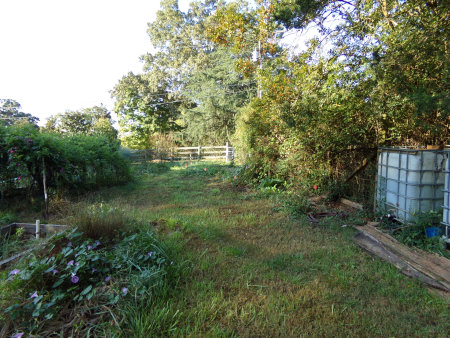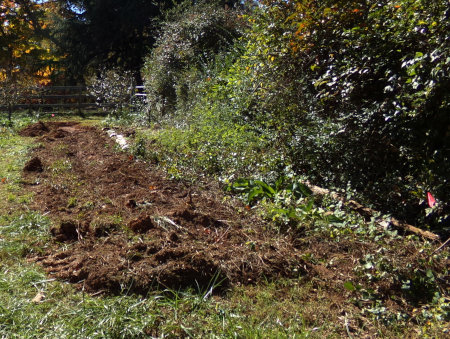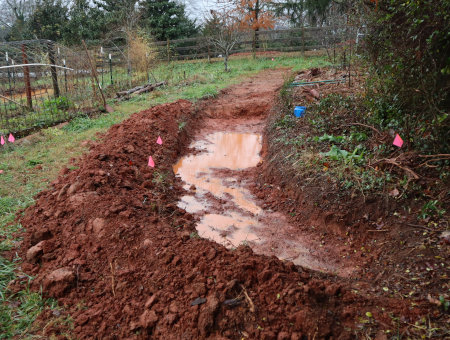One of our winter projects is planning and starting to dig swales. Earlier this month I shared with you my permaculture swale notes and showed you our preliminary swale plan. We decided the first swale should be the one above the garden, because keeping garden soil from drying out a top priority. Dan started by mowing it, and then we used our transit level to find and mark the contour.

|
|
Starting at the fence in the background, the contour gently curves toward the rainwater tank. |
People usually use heavy equipment to form swales, but this is a relatively
short distance (about 40 feet) so we can dig it by hand. It will be a slower
go that way, but we don't really have equipment for swale digging!

|
|
After the swale was marked, Dan used the tractor's scraper blade to scrape away grasses and weeds. |

|
| To loosen the soil, he then made a few passes with his subsoiler. |

|
| Then we got out the shovels and started digging. |
Progress is very much weather dependent, and autumn was a great time to start. Not too hot, and the soil had enough moisture to make digging fairly easy. The goal is to finish before the spring rains. We've been pacing ourselves, planning to spread out the digging over several months.
December was mild and mostly dry. We made fair progress, setting aside some
of the topsoil for another project (more on that later). It finally rained mid-month, and we were very curious about what was going
on in the swale!
It was exciting to see it filling with water! It also gave us an idea of how level our swale bottom is. We're pretty much eyeballing it at this point, with the plan to make corrections after the length of the swale is dug.

|
| How the partially dug swale looked after about a third of an inch of rain. |
It was exciting to see it filling with water! It also gave us an idea of how level our swale bottom is. We're pretty much eyeballing it at this point, with the plan to make corrections after the length of the swale is dug.
We're digging into the clay subsoil, which is sticky and heavy after rain.
That slowed digging, but we managed more progress before it rained again when
January arrived.

|
| This shot was taken January 2nd, after 1.75 inches of rain. |
The above photo was taken on the second day of a three-day rain event. We
got a total of three inches, and were pleased that the swale held it well,
with no blow-outs. It took about two days for all that water to absorb into
the ground,
which is as it should be. Then digging slowed, because the soil was slow to dry out and sticky. But
I was able to make a little more progress before
it snowed.

|
| Taken two weeks after the one above. Can you tell there's progress? |
The snow has been slow to melt and left the ground sticky, so that's as far as we've gotten at the moment. Digging will resume after the ground dries out a bit again. Once
planting weather arrives, I'll plant the berm with perennial herbs and
flowers.
Swale Project: Making a Start © January 2022

13 comments:
Looks like it's doing the trick! Great winter project!
Thanks for the pictures Leigh! It is very helpful. And I did wonder what happens to the exposed soil of the berm, so again helpful.
One question or thought, given on where I think you are: Any concern during summer and swales holding water about creating a mosquito breeding ground?
Thanks, Daisy!
TB, I always try to do the best I can with word pictures, but agree that a photo is truly "worth a thousand words."
The water doesn't stay in the swales long enough to be a problem in regards to mosquitoes. So, no concern about that.
This is very interesting, as always Leigh, and your pictures sure explain things well. The heavy clay sub soil is a plus to slow the absorption. Looking forward to seeing your blooming berms!
Rajani, thanks!
Rosalea, thank you. I think it would be difficult with soil that didn't hold water well. In the tropics, where the soil is shallow and rocky, one source says they tend to make living swales. No digging, just planting a dense hedge of a clump grass like vetiver.
Looking forward to the future report on these swale’s, Leigh! Very awesome project! Is you plan to plant ground cover short flowers, or taller ones…just curious. How are the winter kids doing? I was told to ask you if citrus trees would grow in your area. Have a perfect weekend!
Looks like a positive element for keeping the garden damp - AND for keeping you guys in shape with the digging!! :-)
Wyomingheart, for this swale, I will probably stick to shorter ground cover.
We're too cold for citrus trees. At least to bear fruit. I have a potted Meyer lemon that's outside and got too heavy to move, so one winter I left it. It actually survived, but hasn't born fruit since that time.
RT, yes! That's a great point. I love being able to be physically active. :)
Leigh,
Are you going to connect some how to other swales or diverters to channel water where you need it? Or will all these be stand alone swales?
Kevin, yes, the plan is to connect them. Each one will have a spillway that will flow into another swale. Overflow from this one will be directed to the swale in the adjacent pasture, which hopefully we'll get done this spring!
For projects like this, I remind myself the best way to eat an elephant is one bite at a time. In your case, one shovelful at a time.
Ed, exactly! It really helps to keep that in mind.
I tip my hand-dug swale, hat to you both. They always look so brutal when first dug, as if the land is wearing a scar. But they quickly populate with growing things, that want to take advantage of all that moisture. Then it's like they were always meant to be there.
Post a Comment